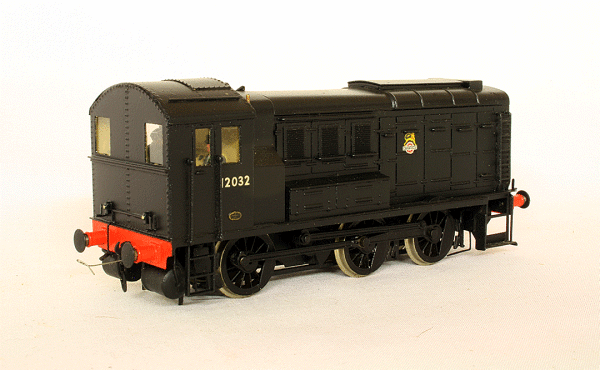Steve Johnson Modelmaker
|
Back to BR Locomotives
|
LMS
12023-12032 0-6-0DE
12032 in BR livery These shunters were a development of the 1934 built 7069-7079 type, but used a single frame mounted motor and jackshaft drive requiring a increase in body length. Built between 1939 and 1942 at Derby Works they used an English Electric 6K 350hp diesel engine and electrical parts. They were built in two batches with detail differences between them. The first batch was numbered 7080-7099 and is covered under 12003-12022. This batch of Lot Number 156 were numbered by the LMS as 7100-7119. During World War 2, ten (7100-7109) were loaned to the War Department. Although they all survived, six were sold to Egyptian Railways and the remaining four to Italian State Railways. The others remained in Britain and upon nationalisation became British Railways 12023-12032 of Class D3/7. They were all withdrawn by 1967 before TOPS classes and numbers were allocated. My take on this shunter is the Judith Edge etched brass kit. The kit follows the usual Judith Edge system of a frame, footplate and body sub assemblies that are all bolted together. I did try a different method of current collection for this model. I used the Alan Gibson sprung pick ups. To use these, a small hole is drilled into the frames behind the metal rim of each wheel. A plastic insert is placed in the hole into which a small spring and brass plunger are placed. The tail of the plunger appears inside the frames to which the motor wires are connected. In 16.5mm gauge, the clearances are quite tight and I had to bend the ends of the tails by 90 degrees so they didn't short on the chassis. The motor wires being a bit more rigid, stop the tails from rotating. It works very well and is all but invisible, but is a bit fiddly with the odd plunger being launched across the workshop never to be seen again! I decided to paint my version in plain BR Black with early crest. A few of the prototypes did end up in BR Green with Wasp Stripes. This was an early kit build for me and is not currently fitted with DCC.
12032 rear view |

